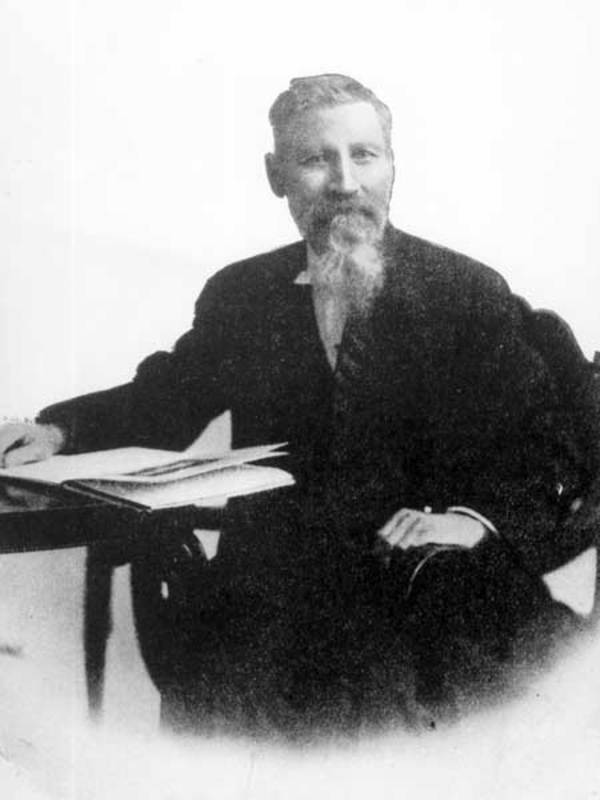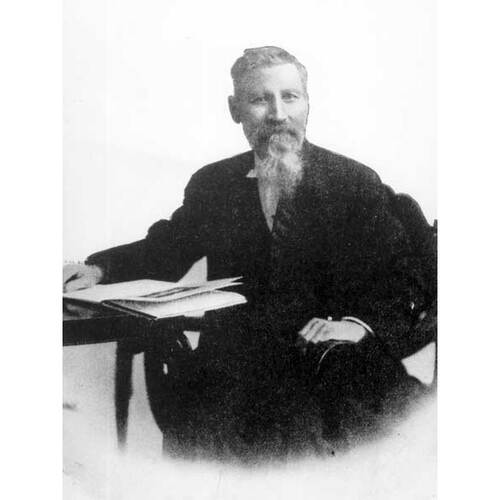
Source: Link
BJARNASON, JÓN, Lutheran minister, periodical editor, educator, and community leader; b. 15 Nov. 1845 in Thvottá, Iceland, son of Bjarni Sveinsson and Rósa Brynjólfsdóttir; m. 15 Nov. 1870 Lara Gudjohnsen in Reykjavík, Iceland; they adopted three children and several foster children lived with them for varied lengths of time; d. 3 June 1914 in Winnipeg.
Jón Bjarnason was one of the most influential leaders among the early Icelandic immigrants to Canada and the United States. He was also an almost constant source of controversy. The son of a Lutheran pastor, he entered the grammar school in Reykjavík in 1861, and graduated from the theological seminary there in 1869, receiving ordination in the Lutheran Church that year. After teaching school in Reykjavík for several years, he emigrated with his wife to the United States in 1873 at the suggestion of a former schoolmate, Pall Thorlaksson.
Initially, he taught at Luther College in Decorah, Iowa. His experiences with the Norwegian Evangelical Lutheran Synod of America influenced his own theology. Impressed with its democratic procedures, he was at the same time uncomfortable with its theological fundamentalism. While at Decorah, he was invited to deliver the sermon at the first Icelandic church service in North America, held in Milwaukee, Wis., on 2 Aug. 1874 to mark the 1,000th anniversary of the settlement of Iceland.
Bjarnason left Luther College in 1875, and found employment first as a translator in Madison, Wis., and then, for a brief period in 1876, with the newspaper Skandinaven [Scandinavian] in Chicago. In March 1876 he moved his family to Minneapolis, Minn., where he became chief editor of the newspaper Budstikken [Rally]. Not long after, he received a call from five congregations in New Iceland, a small colony of about 1,300 Icelandic settlers established on the western shore of Lake Winnipeg. Located in what is now Manitoba, it was at that time in the District of Keewatin, beyond the northern boundaries of the province. He visited New Iceland in July 1877 and took up residence there on 8 November. His local followers hoped that he would keep alive Icelandic church traditions, and also support the retention of the Icelandic language and culture. He brought with him those same aspirations, as well as a liberal theology which denied the infallibility of Scripture.
Thorlaksson too had accepted a call to New Iceland and had arrived shortly before Bjarnason. The theological differences between Thorlaksson, a conservative, and Bjarnason, a liberal, were soon debated by the two in public encounters which drew large audiences and sharply divided the colony. Bjarnason’s followers called themselves the Icelandic Lutheran Synod of America, but the organization they established was short-lived, since its only meeting took place in Gimli on 30 June 1879. Its constitution extended the right to vote at congregational meetings to all men and women over age 18. (Thorlaksson’s followers excluded women and limited the age to 21.)
In 1880 Bjarnason returned to Iceland. He may have been disillusioned with his sojourn in New Iceland, for, among other irritants, he was never paid the salary he had been promised. He had also wished to be near his ailing father. Before leaving, he ordained Halldor Briem on 21 March 1880 and appointed him his successor. He returned to Canada with his family in 1884, after serving a congregation in Seyðisfjörður, Iceland. He had received a call from First Lutheran Church in Winnipeg, which he earlier had helped establish. The congregation grew rapidly after his arrival and became the centre of Icelandic Lutheranism in the city. Bjarnason would continue as pastor until his death in 1914.
The establishment of an Icelandic synod had long been one of Bjarnason’s dreams. On 25 Jan. 1885 several delegates met in Mountain, N.Dak., to organize the Icelandic Evangelical Lutheran Synod of America. The constitution they drafted was modelled on the one Bjarnason had drawn up for the Icelandic Lutheran Synod. The synod’s first annual meeting was held in Winnipeg on 24 June of that year, and Bjarnason was elected its first president. He would hold office until 1908.
The official organ of the synod was the Winnipeg periodical Sameiningin [Unity], which Bjarnason was influential in establishing. He was its first editor and continued in the post until his death. The journal became a voice for his own, often polemical, points of view. He maintained a centrist position theologically, writing scathing indictments of extreme fundamentalism – a continuing expression of his disagreements with Thorlaksson and the Norwegian Synod – and, later, of what he considered to be excessively liberal and radical ideas. Debate seems to have been a constant part of his life.
Always interested in increasing lay involvement in church activities, in 1885 Bjarnason established a youth organization at First Lutheran. Known colloquially as the bandalag, or league, it was formally called the Luther League. Within a few years Luther leagues had been formed by several congregations in Canada and the United States.
While resident in New Iceland, Bjarnason and his wife had established a public school in Gimli, at which Mrs Bjarnason was the principal teacher. At the annual meeting of synod in 1887, Bjarnason offered to contribute $100 to a fund to establish a church-related Icelandic academy. Nothing further developed. The issue was again raised in 1890, but plans did not proceed because Bjarnason fell ill. In 1893 the need for a library to serve the Icelandic community and an eventual academy was identified and Bjarnason managed to collect money to buy a private collection from Iceland and promised to donate his own library after his death. There was continued public debate about the feasibility of the educational institution, its relation to the church, and whether it should be built in the United States or Canada. Finally, Winnipeg was selected as the site and in 1898 a board of directors was chosen. By then, over $6,000 had been raised. The project advanced no further, however.
In 1901, through the efforts of Bjarnason and other leaders in the Icelandic community, an agreement was reached with Wesley College [see Joseph Walter Sparling] on the inclusion of Icelandic language and literature in its curriculum. Bjarnason was appointed one of the examiners. This agreement seemed to satisfy, at least temporarily, the community’s aspirations for higher education.
After remaining dormant for over a decade, the concept of an Icelandic academy was formalized in 1911 and in 1913 the school opened its doors to 36 students in rented quarters. At first, all students were Icelandic, and were required to take language courses in Icelandic. The issue of religious affiliation was resolved when the synod decided to emphasize a Christian, rather than exclusively Lutheran, orientation. Icelandic Unitarians attended, and were excused from the otherwise mandatory attendance at chapel services. In time students came from several provinces and the United States.
Initially the academy offered elementary education, one year of high school, and a course for Sunday-school teachers. Other high school grades were added and the elementary classes eliminated. Although it was known as the Jón Bjarnason Academy from the beginning, the name became official only after Bjarnason’s death in 1914. Permanent quarters were found in 1923 and the academy continued until 1940. It had been a centre for Icelandic social and cultural organizations and its library had been widely used.
The Reverend Jón Bjarnason was a man who seems to have always been at the midst of controversy, something which he enjoyed. As a schoolboy in Reykjavík, he had been critical of both fellow students and faculty. Still, his writings suggest that he was respectful of most of those with whom he disagreed. A charismatic individual with a wife who was his partner and supporter, he was certainly one of the most influential persons in the early history of Icelandic settlement in North America.
V. J. Eylands, Lutherans in Canada, intro. F. C. Fry (Winnipeg, 1945). G. J. Houser, Pioneer Icelandic pastor: the life of the Reverend Paul Thorlaksson (Winnipeg, 1990). W. Kristjanson, The Icelandic people in Manitoba: a Manitoba saga (Winnipeg, 1965). Minningarrit um Séra Jón Bjarnason, 1845–1914 . . . [In memoriam, the Reverend Jón Bjarnason] (Winnipeg, 1917). R. H. Ruth, Educational echoes; a history of education of the Icelandic-Canadians in Manitoba (Winnipeg, 1964). Jonas Thor, “A religious controversy among Icelandic immigrants in North America, 1874–1880” (ma thesis, Univ. of Man., Winnipeg, 1980).
Cite This Article
John S. Matthiasson, “BJARNASON, JÓN,” in Dictionary of Canadian Biography, vol. 14, University of Toronto/Université Laval, 2003–, accessed April 22, 2025, https://www.biographi.ca/en/bio/bjarnason_jon_14E.html.
The citation above shows the format for footnotes and endnotes according to the Chicago manual of style (16th edition). Information to be used in other citation formats:
| Permalink: | https://www.biographi.ca/en/bio/bjarnason_jon_14E.html |
| Author of Article: | John S. Matthiasson |
| Title of Article: | BJARNASON, JÓN |
| Publication Name: | Dictionary of Canadian Biography, vol. 14 |
| Publisher: | University of Toronto/Université Laval |
| Year of revision: | 1998 |
| Access Date: | April 22, 2025 |



